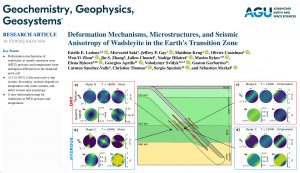 Former TIMEleSS student Estelle Ledoux is the first author of Deformation Mechanisms, Microstructures, and Seismic Anisotropy of Wadsleyite in the Earth’s Transition Zone, published in gold open-access in AGU’s Geochemistry, Geophysics, Geosystems.
Former TIMEleSS student Estelle Ledoux is the first author of Deformation Mechanisms, Microstructures, and Seismic Anisotropy of Wadsleyite in the Earth’s Transition Zone, published in gold open-access in AGU’s Geochemistry, Geophysics, Geosystems.
Rocks deep inside the Earth mantle are deforming plastically under the effect of mantle convection. In return, the way minerals accommodate deformation impacts the properties of the whole rock and controls mantle flow. The deformation mechanisms of upper mantle minerals have been studied extensively. The behavior of minerals found deeper in the Earth, however, still remains debated and poorly understood.
Wadsleyite is the high pressure polymorph of olivine and the major phase of the upper part of the mantle transition zone (MTZ) (at 410–520 km depth) and then is suspected to control the deformation of that region of the mantle. Investigations of deformation mechanisms in wadsleyite have been scarce and only made recently possible with in-situ measurements at relevant pressure and temperature.
Here, using in-situ deformation experiments, multigrain X-ray crystallography, literature results, and numerical simulations, we propose a new view of plastic deformation of wadsleyite in the Earth’s MTZ. We show that it will be strongly affected by both temperature and water content. We then provide models that could be used for the seismic detection of its anisotropic behavior and mapping mantle flow using seismic measurements.
Congratulations Estelle!









